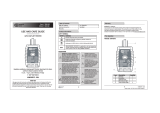
3
�Warnings: Read Before Using
To avoid the possibility of electric shock or personal injury:
• Use the Product only as specified in this manual or the protection provided by the
instrument may be compromised.
• Avoid working alone so assistance can be rendered.
• Test on a known signal source within the rated voltage range of the Product both before
and after use to ensure the Product is in good working conditions.
• Do not use the Product around explosive gas, vapor, or in damp or wet environments.
• Inspect the Product before use and do not use if it appears damaged. Check for cracks or
missing plastic. Pay particular attention to the insulation around the connectors.
• Inspect the test leads and other accessories before use. Do not use if insulation is
damaged or metal is exposed.
• Do not use the Product if it operates incorrectly. Protection may be impaired. When in
doubt, have the Product serviced.
• Check the test leads for continuity. Replace damaged test leads before using the Product.
• Have the Product serviced only by qualified service personnel.
• Use extreme caution when working around bare conductors or bus bars. Contact with
the conductor could result in electric shock.
• Do not hold the Product beyond the tactile barrier.
• Do not apply more than the rated voltage and CAT rating, as marked on the Product,
between the terminals or between any terminal and earth ground.
• Remove test leads from the Product before opening the Product case or battery cover.
• Never operate the Product with the battery cover removed or the case open.
• Use caution when working with voltages above 30 V AC RMS, 42 V AC peak, or 60 V DC.
These voltages pose a shock hazard.
• Do not exceed the Measurement Category (CAT) rating of the lowest rated individual
component of a Product, probe, or accessory.
• Do not attempt to connect to any circuit carrying voltage that may exceed the maximum
range of the Product.
• Use the proper terminals, functions and ranges for your measurements.
• When using alligator clips and test probes, keep fingers behind the finger guards.
• Use only exact fuse replacement and specified replacement parts.
• When making electrical connections, connect the common test lead before connecting
the live test lead; when disconnecting, disconnect the live test lead before disconnecting
the common test lead.
• To avoid false readings that can lead to electrical shock and/or injury, replace the
batteries as soon as the low battery indicator appears. Check Product operation on a
known source before and after use.
• Use only AA batteries, properly installed in the Product case, to power the Product (see
Section 5.1: Battery Replacement).
• When servicing, use only specified user serviceable replacement parts.
• Adhere to local and national safety codes. Individual protective equipment must be used
to prevent shock and arc blast injury where hazardous live conductors are exposed.
• Only use the test lead provided with the Product or UL Listed Probe Assembly rated
CAT IV 600 V or better.
• Do not use the HOT STICK (TIC 410A) to operate the AT-8000-R Receiver at voltages above 600 V.
• Remove the batteries if the Product is not used for an extended period of time, or if
stored in temperatures above 122 °F (50 °C). If the batteries are not removed, battery
leakage can damage the Product.
• Follow all battery care and charging instructions from the battery manufacturer.
• Do not use the Product to check for absence of voltage. Please use an appropriate voltage
tester instead.
1. PRECAUTIONS AND SAFETY MEASURES























